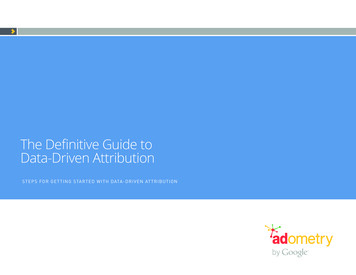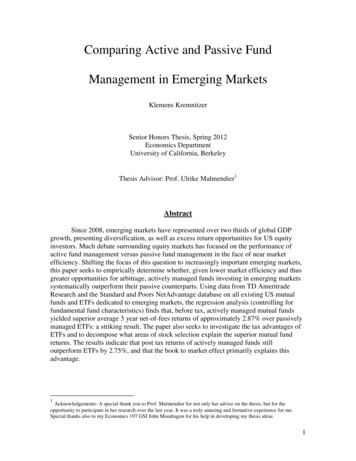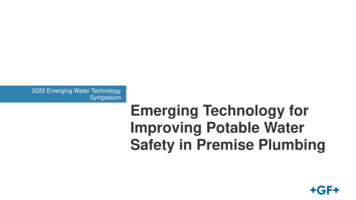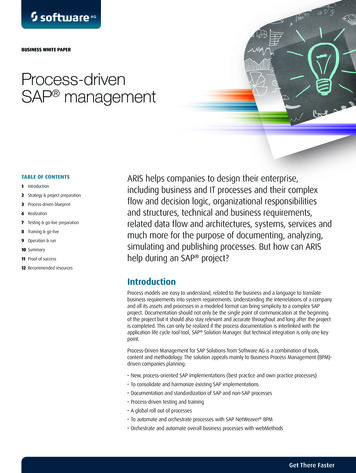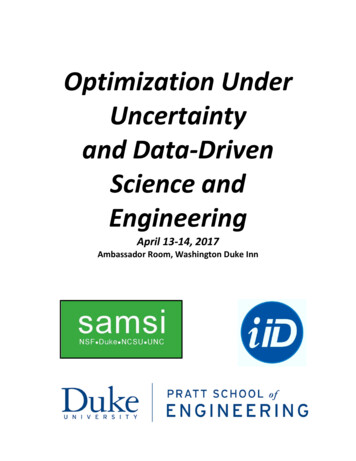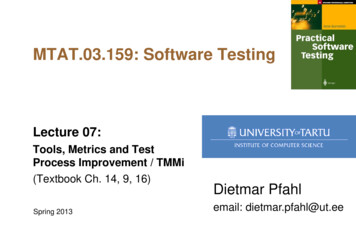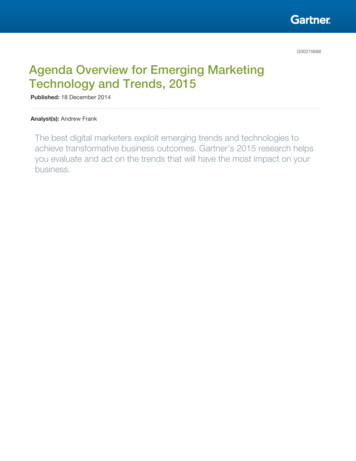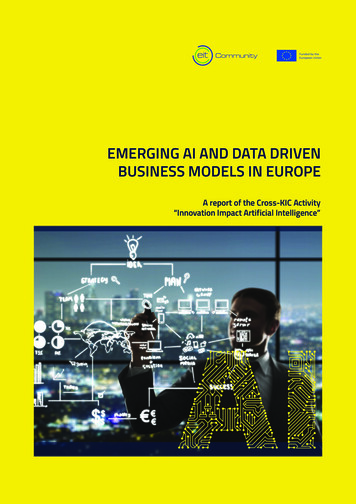
Transcription
EMERGING AI AND DATA DRIVENBUSINESS MODELS IN EUROPEA report of the Cross-KIC Activity“Innovation Impact Artificial Intelligence”
EMERGING AI AND DATA DRIVEN BUSINESS MODELS IN EUROPECONTENTS1EXECUTIVE SUMMARY4LIST OF FIGURES2.OVERVIEW OF EU LEADERSHIP IN AI5FIGURE 1 MOST RESPONDERS ARE AI PROVIDERS15FIGURE 2 AI ALGORITHM DEVELOPMENT APPROACHES152.1.AI LANDSCAPE IN EU52.2.NATIONAL AI INITIATIVES OF EUROPEAN COUNTRIES52.3.AI REGULATORY FRAMEWORK AND ETHICAL GUIDELINES IN EU82.4.EUROPEAN ADVANTAGES IN AI DEVELOPMENT3AI BUSINESS MODEL3.1.3.2.10FIGURE 3 50% OF AI DEVELOPERS RELY ON EXTERNAL PARTNERS TODEVELOP AI SOLUTION 16FIGURE 4 DEPLOYMENT OF DIFFERENT AI SOLUTIONS AMONG XKIC AI PARTNERS 16FIGURE 5 REVENUE GENERATION BY AI ADOPTION1713FIGURE 6 COST REDUCTION BY AI ADOPTION17AI BUSINESS MODEL13FIGURE 7 XKIC AI ADOPTERS’ VIEW OF AI BENEFITS18METHODOLOGY14FIGURE 8 XKIC AI PROVIDERS’ VIEW OF AI BENEFITS183.3.SURVEY FINDINGS15FIGURE 9 BARRIERS FOR DEPLOYING AI SOLUTIONS194.AI APPLICATIONS IN THE CLIMATE SECTOR25FIGURE 10 RISKS FOR ADOPTING AI SOLUTIONS19FIGURE 11 DESIRED FEATURES OF A DATA PLATFORM204.1.AI’S IMPACT ON CLIMATE254.2.RISKS OF AI IMPLEMENTATION295.AI APPLICATIONS IN THE MANUFACTURINGSECTOR315.1.PRODUCT31FIGURE 14 XKIC AI DEVELOPERS’ PERSPECTIVE ON THEIR OWN DATA SECURITY5.2.OPERATIONS / LOGISTICS31FIGURE 15 XKIC AI DEVELOPERS’ CONCERN ON THEIR CUSTOMERS’5.3.COMMERCIAL33DATA SECURITY 215.4.ENVIRONMENTAL IMPACT33FIGURE 16 DATA AVAILABILITY FROM XKIC AI DEVELOPERS’ PERSPECTIVE6.AI APPLICATIONS IN THE MOBILITY SECTOR6.1.AI IN MOBILITY SERVICES6.2.AI APPLICATIONS — AUTOMATIC PASSENGER TRANSPORTATION 366.3.AI APPLICATIONS — “ROBOTIZATION” OF LOGISTICS386.4.AI APPLICATIONS — TRAFFIC MANAGEMENT OPERATIONS396.5AI APPLICATIONS — INSURTECH407.AI APPLICATIONS IN THE HEALTHCARE SECTOR 42FIGURE 22 AI ADOPTION IN HEALTHCARE BUSINESS OPERATIONS427.1.AI HEALTHCARE IN EUROPE42FIGURE 23 TOP AI APPLICATIONS IN HEALTHCARE437.2.AI IMPACT IN HEALTHCARE42FIGURE 24 AI SOLUTIONS’ DEPLOYMENT IN HEALTHCARE ORGANISATION438.AI APPLICATIONS IN OTHER SECTORSFIGURE 25 AREAS OF AI IMPACT IN HEALTHCARE438.1.AI IN SECURITY538.2.AI IN ENTERTAINMENT538.3.AI IN EDUCATION538.4.AI IN PUBLIC ADMINISTRATIONS539.EIT SUPPORTED INNOVATIONS IN AI5510.CONCLUDING REMARKS5711.ACKNOWLEDGEMENT58ANNEX I2FIGURE 12 XKIC AI DEVELOPERS’ PERSPECTIVE ON THEIR OWNDATA GOVERNANCE BODY 20FIGURE 13 XKIC AI DEVELOPERS’ VIEW ON THEIR CUSTOMERS’35355359DATA GOVERNANCE BODY 202121FIGURE 17 DATA QUALITY FROM XKIC AI TECHNOLOGYDEVELOPERS’ PERSPECTIVE 22FIGURE 18 DATA INTEGRITY FROM XKIC AI DEVELOPERS’ PERSPECTIVE23FIGURE 19 THE COSTLIEST ACTIVITIES FOR ADOPTING AI SOLUTIONS 23FIGURE 20 APPROACHES THAT XKIC AI ADOPTERS TOOK TO DRIVE AI VALUE23FIGURE 21 APPROACHES THAT XKIC AI PROVIDERS HELP THEIR CUSTOMERSTO DRIVE AI VALUE 24AbbreviationAIArtificial IntelligenceAIAaaSAI Application-as-a-ServiceAIIaaSAI Infrastructure-as-a-ServiceDRTDemand Responsive TransportDGData governanceEITEuropean Institute of Innovation and TechnologyXKICCross Knowledge Innovation CommunitiesMaaSMobility-as-a-ServicePoCProof of Concept
EMERGING AI AND DATA DRIVEN BUSINESS MODELS IN EUROPELIST OF TABLESTABLE 1 THE BENEFITS OF AI ECOSYSTEM TO EUROPEAN SOCIETY AND ECONOMY 5TABLE 23 EUROPEAN EXAMPLES OF AI APPLICATIONS IN AUTONOMOUS TRUCKS 37TABLE 2 COMPARISON OF CURRENT AND FUTURE DATA MANAGEMENTTABLE 24 EUROPEAN EXAMPLES OF AI APPLICATIONS IN AUTONOMOUS SHIPS38PRACTICE IN EUROPE 6TABLE 25 EUROPEAN EXAMPLES OF AI APPLICATIONS IN TRAFFIC PREDICTION38TABLE 3 ILLUSTRATION OF AI POLICIES, OBJECTIVES AND STRATEGIESTABLE 26 EUROPEAN EXAMPLES OF AI APPLICATIONS IN ON-DEMANDOF EUROPEAN COUNTRIES 7 - 9TRANSPORT 39TABLE 4 EU’S OVERARCHING REGULATORY FRAMEWORK ANDTABLE 27 EUROPEAN EXAMPLES OF AI APPLICATIONS IN VEHICLE TRACKINGETHICS GUIDELINES ON AI 10TABLE 28 EUROPEAN EXAMPLES OF AI APPLICATIONS INTABLE 5 EXAMPLES OF RESEARCH COLLABORATION FROM CROSS-DISCIPLINES11AIR TRAFFIC MANAGEMENT 40TABLE 6 AI BUSINESS MODEL14TABLE 29 EUROPEAN EXAMPLES OF AI APPLICATIONS IN CAR INSURANCETABLE 7 SELECTED OPPORTUNITIES TO REDUCE GHG EMISSIONSFROM ELECTRICITY SYSTEMS USING AI3940TABLE 30 EUROPEAN EXAMPLES OF AI APPLICATIONS IN25REMOTE PATIENT MONITORING 44TABLE 8 SELECTED STRATEGIES TO MITIGATE GHG EMISSIONS FROMTABLE 31 EUROPEAN EXAMPLES OF AI APPLICATIONS ITRANSPORTATION USING AI 26N PERSONALISED CARE 44TABLE 9 SELECTED STRATEGIES TO MITIGATE GHG EMISSIONS FROMTABLE 32 EUROPEAN EXAMPLES OF AI APPLICATIONS INSMART CITY USING AI 27REMOTE DIAGNOSIS 45TABLE 10 RISKS OF AI IMPLEMENTATION IN CLIMATE SECTORTABLE 33 EUROPEAN EXAMPLES OF AI APPLICATION IN29TABLE 11 EUROPEAN EXAMPLES OF AI APPLICATIONS IN MANUFACTURINGCARDIOVASCULAR MONITORING 45QUALITY CHECKS 31TABLE 34 EUROPEAN EXAMPLES OF AI APPLICATIONS IN ASSESSINGTABLE 12 EUROPEAN EXAMPLES OF AI APPLICATION IN MANUFACTURINGCHRONIC DISEASE 46GENERATIVE DESIGN 31TABLE 35 EUROPEAN EXAMPLES OF AI APPLICATIONS IN DISCOVERINGTABLE 13 EUROPEAN EXAMPLES OF AI APPLICATIONS IN PREDICTIVEEARLY STAGE DISEASE 46MAINTENANCE 32TABLE 36 EUROPEAN EXAMPLES OF AI APPLICATIONS INTABLE 14 EUROPEAN EXAMPLES OF AI APPLICATIONS IN SUPPLY CHAINCLINICAL DIAGNOSTICS 46COMMUNICATION 32TABLE 37 EUROPEAN EXAMPLES OF AI APPLICATIONS MEDICAL DIAGNOSIS47TABLE 15 EUROPEAN EXAMPLES OF AI APPLICATIONS IN ROBOTICS33TABLE 38 EUROPEAN EXAMPLES OF AI APPLICATIONS IN DISEASE DETECTION47TABLE 16 EUROPEAN EXAMPLES OF AI APPLICATIONS IN DIGITAL TWINS33TABLE 39 EUROPEAN EXAMPLES OF AI APPLICATIONS INTABLE 17 EUROPEAN EXAMPLES OF AI APPLICATIONS IN COMMERCIALDOCTOR PRODUCTIVITY 47ACTIVITIES IN MANUFACTURING SECTOR33TABLE 40 EUROPEAN EXAMPLES OF AI APPLICATIONS IN IMAGE PROCESSING48TABLE 18 FUNCTIONS OF AI APPLICATIONS IN MOBILITY SERVICES35TABLE 41 EUROPEAN EXAMPLES OF AI APPLICATIONS IN CARE DELIVERY48TABLE 19 EUROPEAN EXAMPLES OF AI APPLICATIONS INTABLE 42 EUROPEAN EXAMPLES OF AI APPLICATIONS IN POPULATIONAUTONOMOUS VEHICLES 36HEALTH MANAGEMENT 49TABLE 20 EUROPEAN EXAMPLES OF AI APPLICATIONS IN DRIVERLESS BUSSES36TABLE 43 EUROPEAN EXAMPLES OF AI APPLICATIONS IN DRUG TESTING50TABLE 21 EUROPEAN EXAMPLES OF AI APPLICATIONS IN AUTONOMOUS TAXIS36TABLE 44 EUROPEAN EXAMPLES OF AI APPLICATIONS IN PRECISION MEDICINE50TABLE 22 EUROPEAN EXAMPLES OF AI APPLICATIONS IN FLYING DRONES TAXIS37TABLE 45 EIT SUPPORTED INNOVATIONS IN AI553
EMERGING AI AND DATA DRIVEN BUSINESS MODELS IN EUROPE1. EXECUTIVE SUMMARYWith its capability of driving productivity and economic development, Artificial Intelligence (AI) is already having a huge impacton our everyday lives in recent years. The European Institute of Innovation and Technology (EIT), a body of the European Union,is well positioned with its vast network and broad thematic coverage to help Europe make the most of Artificial Intelligence’spotential and keep up with the AI technological race.The EIT Innovation Communities (KICs) EIT Climate-KIC, EIT Digital, EIT InnoEnergy, EIT Health, EIT Manufacturing, and EIT UrbanMobility have joined forces in a cross-KIC activity to foster collaboration in, education about, and uptake of Artificial Intelligenceby European enterprises and society. In 2020, the main focus of the joints activities was taking stock of the state of AI in theKICs innovation, education, and business creation ecosystems. As part of that, EIT Urban Mobility led this study by focusing onexisting AI technology business models and applications across urban mobility, climate, manufacturing and healthcare sectorsin EU1. We engaged over 60 individuals from EIT AI partners and captured their perspectives on the practices of AI technologies.The survey included the sections of barriers and risks for AI adoption, methodological approaches to AI algorithm development,and business models for AI deployment. Building upon the survey results, we also conducted a systematic secondary researchof AI landscape, business approach and practices in EU. The report segmented AI applications with the main focus on the valuecreation of AI technologies in the existing and established sectors.In summary, this report contains the results of the surveys and desk research study including: Mapping AI landscape across Europe focusing on the area of national initiatives, regulatory framework and ethical guidelines Conducted a XKIC survey with EIT AI partners and received over 60 valid responses Consolidation of various AI business models in Europe Consolidation of EIT AI partners’ perspective on AI benefit realisation Systematic mapping of AI applications across health, manufacturing, urban mobility, and climate in EuropeWe recommend the creation of a backend database capturing evolving EU AI applications with proven business models. By systematically segmenting the existing AI solutions across verticals, the database would strengthen EIT’s leading position in helpingEU advance AI development and deployment in 2021. The database would also be used as the backbone for an online platformpresenting EU successful cases of AI applications. The live platform would aim to streamline knowledge, experience, and expertise in AI deployment, connect, share and encourage an open innovation environment with policy leaders, industrial experts, andinnovator communities. To achieve such goals, EIT is recommended to work more closely with its ecosystem partners to builddata sharing culture, to facilitate wider collaboration, and to demonstrate European leadership in building AI-driven businesseslocally, regionally and internationally.14AI in Energy is an area to examine for next year’s report.
EMERGING AI AND DATA DRIVEN BUSINESS MODELS IN EUROPE2. OVERVIEW OF EULEADERSHIP IN AIAI is already transforming business, and this trend is only setto continue. The power of AI is understood by business leadersregardless of company size: from companies with annual revenue over 8 billion to as low at 200 million, with remarkableconsensus across business size and sectors. A Forbes Insightssurvey in 2018 showed that, among 300-plus executives, 95%believe that AI will play an important role in their responsibilities in the near future2.The US, China, and Europe are main leading competitors inAI development. China is closely following the top leader, theUS, and aims to lead by 2030. For the EU, the focus mightbe more on finding the ways to embracing the opportunitiesoffered by AI in a way that is human-centred, ethical, secure,and true to its fundamental values3.Europe has technological and industrial strengths with ahigh-quality digital infrastructure and a regulatory framework based on its fundamental values to become a globalleader in innovation and its applications as set out in the European data strategy. On that basis, the whole of Europeansociety and economy will benefit from its AI ecosystem for itscitizens, businesses and public services (Table 1).2.1. AI LANDSCAPE IN EUEurope is home to 1,600 early-stage AI software companies.AI entrepreneurship is becoming mainstream. Today, one in12 put AI at the heart of their value proposition. Among themain European players in AI, the UK, Germany and Franceprogress fast from strategic frameworks to AI practices5.French AI start-ups became the most European funded,expected to reach 1.14 billion in 20196. At city-level, thetop 10 AI start-up hubs within the EU are London, Berlin,Target GroupsParis, Madrid, Stockholm, Amsterdam, Copenhagen, Barcelona, and Dublin7. According to European Commission, thetop 5 industries AI companies operate in are FinTech, HealthTech, MadTech (marketing, advertising and technology),business intelligence, and automotive8. Collectively, European AI start-ups raised 6.7 billion in 2020, almost doublingthe figure in 2017.As one of the most important applications of data economy, AI drives Europe’s current and future sustainable economic growth and societal wellbeing by value creation fromdata. Largely AI companies in the EU focus on B2B, whichrepresents 76% of the business compared to 24% for B2C(business-to-consumer)9. Moving from consumer focused,centralised cloud based to industrialised and distributededge cloud architecture, future AI practices will continue tostrengthen EU’s leading position in digitised B2B industryand building the next edge-cloud ecosystem (Table 2).2.2. NATIONAL AI INITIATIVESOF EUROPEAN COUNTRIESBeing in a global AI race, the world’s largest economies have allmade announcements about their nation state AI strategies.For example, US claims the Top Spot in Global AI Investmentwhereas China has not been shy about its intent to become aworld leader in AI by 2030.European nations have been also active in AI, for example,the French government intends to spend 1.85 billion overthe next five years to support the AI ecosystem including thecreation of large public datasets. However, the risks facingEuropean countries are that they could fall into subsidising talent for the global AI giants and accelerate the wealthBenefits examplesFor citizensImproved health care, fewer breakdowns of household machinery, safer and cleaner transport systems, betterpublic services.For business developmentA new generation of products and services in areas where Europe is particularly strong (machinery, transport,cybersecurity, farming, the green and circular economy, healthcare and high value added sectors like fashionand tourism).For services of publicinterestReducing the costs of providing services (transport, education, energy and waste management); Improvingthe sustainability of products and equipping law enforcement authorities with appropriate tools to ensure thesecurity of citizens, with proper safeguards to respect their rights and freedoms.Table 1. The benefits of AI ecosystem to European society and economy45
EMERGING AI AND DATA DRIVEN BUSINESS MODELS IN EUROPECurrent PracticeFuture PracticeData SourceRelated to consumersFrom industry, business and the public sector.Data Storage andProcessingOn central cloud-based infrastructureOn a variety of systems, notably on computing devicesworking at the edge of the network.Status of DevelopmentA relatively weak position in consumer platformsA strong position in digitised industry and business-to-business applications.Table 2. Comparison of current and future data management practice in in Europe10of other sovereign nations11. Also, whether strict regulationson data privacy and ethical AI slow down European countries’AI innovation are debated. The recurring work has highlighted the need for coordinated actions at EU level – given data,privacy and services are being offered across the singlemarket.Germany launched its AI strategy (December 2018)Aim: To become a leading centre for AI by pursuing speedy andcomprehensive transfer of research findings into applications.AI Strategy: To meet with infrastructure requirements, provideenhanced access to data, skills development, and security toprevent misuse and ethical dimensions. e.g., Ethical guidelinesfor self-driving cars (BMVI, 2017) 12.France announced its AI strategy (March 2018)Aim: To allocate 1.5 billion of public funding to AI by 2022 tohelp France become an AI research and innovation leader13.AI Strategy: Calls for investment in public research and education and build world- class research hubs linked to industry through public-private partnerships. “Upgrade” existingindustries. Starting from applications in health, environment,transport and defence, the French AI initiative aims to use AIto renew existing industries. It proposes to prioritise access todata by creating “data commons” between private and publicactors; adapt copyright law to facilitate data mining; and openpublic sector data to industry partners14.Spain launched National R&D and Innovation Plan (20172020).Aim: To invest 90 million in digital society and language technology between 2016 and 2021.The investment will focus onareas related to infrastructure, public administration, industry,and lighthouse projects.AI Strategy: To focus on four core areas: (1) talent, (2) science, (3) industry, and (4) social challenges, alongside severalstrategic actions such as digital society, language technology,and Industry 4.0.6Poland published a draft of national AI strategy (Ministry ofDigitization, 2019)Aim: To encourage the growth and innovation of the knowledge-based economy by supporting AI science and researchdevelopments and to prepare citizens for the digital transformation by improving their competences.AI Strategy: to account for the protection of human dignity andto ensure conditions for fair competition. The Polish strategyis providing strategic guidance and policy initiatives to develop a holistic AI ecosystem to meet the following objectives:1) reforming the educational system in AI-related fields;2) encouraging growth and innovation of AI companies;3) increasing national and international partnerships in AI;Finland announced Finland’s Age of Artificial Intelligence(October 2019)Aim: To develop a safe and democratic society with AI; to useAI to provide the best public services in the world; and for AI tobring new prosperity, growth and productivity to citizens.AI Strategy: A roadmap for the country to leverage its educated population, advanced digitalisation and public sector dataresources. The strategy foresees building international linksin research and investment and encouraging private investments16,17.Italy published “AI at the Service of Citizens” (March 2018)Aim: To leverage AI technologies to serve people and businessand increase public- service efficiency and user satisfaction. Toaddress challenges to implement AI in public services relatedto ethics, technology, data availability and impact measurement.AI Strategy: Along the process of achieving the objectives Italyhighlights the importance of accounting for the protection ofhuman dignity and ensuring conditions for fair competition.Summing above, German’s objective is to become a leading centre for AI bypursuing speedy and comprehensive transfer of researchfindings into applications.
EMERGING AI AND DATA DRIVEN BUSINESS MODELS IN EUROPE France focus on become an AI research and innovationleader to help use AI to renew existing industries. Spain draw attention on digital society and languagetechnology. Italy to leverage AI technologies to serve people andbusiness and increase public-service efficiency and usersatisfaction.There are also both commonalities and differences betweenEU countries in terms of governmental initiatives and funding,ethical guidelines, source of investments. For example, Ethical dimension and human dignity for AI developmentare addressed by most EU countries. The majority of EU countries recommend distributed butcooperative AI clusters as key next steps.CountryEU Infrastructure and industry update are called by a numberof EU countries, while there are differences in the focus onindustry sectors. Education and talent are recognised as core competencesfor AI by most EU countries. Most countries view data as the key to develop AI and areworking on suitable data solutions. There are differences in public acceptance, usage, anduptake of ICT technologies across European countries. Academia across Europe actively counteracts fragmentation between different AI-related disciplines and usesopportunities to cross-pollinate with industry and government.AI Policy DocumentAI ObjectiveAI Strategy18,19,20,21Top Influenti al AICompanies22,23,24EuropeanCommission’sWhite Paper on ArtificialIntelligence – A EuropeanApproach to Excellence andTrust (2020)Promote the uptake of AIWork with member statesThe 7bridgesAddress the risks associatedwith certain uses of AIFocus on the efforts of the research and innovation communityStrong focus on skills to fill competence shortagesReplaiEuropean Commission’s policies for shaping Europe’sdigital future:Focus on SMEsHoravisi onQuortex Bubo.AIPartnership with the private sectorAdvancing in digital scienceand infrastructuresPromote the adoption of AI by thepublic sector Secure access to dataand computing infrastructures Exercise global leadership in buildingalliancesResponsible Research andInnovation in ICT-relatedparts of H2020Information & Communication Technologies in Horizon2020GermanyThe Federal Government’sArtificial Intelligence Strategy (2018).Make Germany and Europeglobal leaders on the development and use of AI. technologies and secure Germany’s competitiveness in thefuture.Safeguard the responsibledevelopment and use of AIwhich serves the good ofsociety.Integrate AI in society in ethical, legal, cultural and institutional terms in the contextof a broad societal dialogueand active political measures.Strengthen research in Germany todriver innovation.DeepSpiInnovation competitions and European innovation clusters.SpeechTe xt.Transfer to business, strengthenthe Mittelstand.Foster the founding of new businesses and lead them to successWorld of work and labour market:shaping structural change.AskBrianAIdelphaiSPRK.globalStrengthen vocational training andattracting skilled labour/experts.Use AI for tasks reserved for thestate and administrative tasksMake data available and facilitate its use Adapt the regulatoryframework National and international networkingEngage in dialogue with societyand continuing the developmentof the framework for policy actionTable 3: Illustration of AI policies, objectives and strategies of European countries.7
EMERGING AI AND DATA DRIVEN BUSINESS MODELS IN EUROPECountryFranceAI Policy DocumentAI ObjectiveAI Strategy18,19,20,21Top InfluentialAI Companies22,23,24For a Meaningful Artificial Intelligence Towardsa French and EuropeanStrategy prepared byFrench deputy Cédric Villani (2018)Improve the AI education andtraining ecosystem to develop and attract the best AItalentBuild a data-focused economic policyPromote agile and enabling researchQuortexEstablish an open data policyfor the implementation of AIapplications and pooling assets togetherDevelop an ethical framework for a transparent andfair use of AI applicationsSpainRDI Strategy in ArtificialIntelligence (2019)Establish a series of priorities and policy recommendations to create anappropriate ecosystem for development and application ofAI-technologies.Assess the effects of AI on the futureof work and the labour market, andexperiment adequate policy responsesArtificial intelligence working for amore ecological economy Ethical considerations of AIUbble.aiExJewelZama LinguaCustodiaInclusive and diverse AI.Developing a framework for the development of solid IA RDI system andthe analysis of its socio-economicimpactIdentifying key priority areas in whichresearch and innovation in AI shouldbe maximized.Facilitate the transfer of knowledgeand its return to societ.yUnicsoftKoukio SolutionsArus DefenceSerendee piaResearch BismartFoster the development of educationand competences in the field of A.IEstablish a digital data ecosystemand enhance the available digital infrastructures.Analyse and develop an ethicalframework from an RDI t Policy inPoland for 2019-2027(2019)Encourage growth and innovation of the knowledge-based economy bysupporting AI science andresearch developments andprepare citizens for the digitaltransformation by improvingtheir competencesReform the educational system andprovide lifelong learning opportunities in AI-related fieldsNeotericEncourage growth and innovation ofAI companies through dedicated support in AI research, including the provision of sufficient financial resourcesNetguruAccount for the protectionof human dignity and ensureconditions for fair competition.Increase national and internationalpartnerships in AIIntelliasSTXNext MiquidoCreate a data ecosystem with trustworthy and high-quality data and increased data exchange mechanismsReinforce the digital infrastructure,regulatory framework and test environments to foster the developmentof AI innovationsRelease more concrete investmentplans that could be earmarked to foster AI development2.3. AI REGULATORY FRAMEWORKAND ETHICAL GUIDELINES IN EUAll 28 Member States of European Commission plus Norwayhave signed the Digital Day Declaration ‘Declaration of Cooperation on AI’. In the Declaration, Member States agree to worktogether towards a comprehensive and integrated Europeanapproach on AI and, where needed, review and modernisenational policies to ensure that the opportunities arising fromAI are seized and challenges addressed. The Declaration aimsto build a framework for cooperation on areas ranging fromAI’s impact on the labour market, sustainability and trustworthiness to ethics and funding.8Importantly, the Declaration demonstrates a clear concernfor the ethical issues arising out of current and future AI-system’s development and deployment. The Declaration commitsits signatories to ensuring that ‘humans remain at the centreof AI development, and to prevent the harmful creation anduse of AI applications. Table 3 outlines the EU’s overarchingregulatory framework and ethics guidelines on AI25 , which further complement the EU’s AI strategy, and demonstrate theEU’s intention to be a leader in ‘ethical AI’.
EMERGING AI AND DATA DRIVEN BUSINESS MODELS IN EUROPECountryCountryFinlandAI Policy DocumentAI ObjectiveAI Policy DocumentFinland’s Age of ArtificialIntelligence (2018)AI ObjectiveIncrease the competitivenessof business and industryAI Strategy18,19,20,21AI Strategy18,19,20,21Support education and training in AIwith particular attention devoted tothe working-age population targetingItalyNationalon ProvideImprove AI-relatedskillsand vocationalStrengthentrainingthe provisionof AIlearncomand lifelongWorkin theStrategyAge of encesat all theeducapetencesat all education esand improveef- ing(2019a)tion levelsandpubliccreatesec-torlifelongficiencyof theReinforcepublicfundingthe thegapavailableof availableskillsandLeading the way into the learning and reskill opportu- Closenities for athe well-functioninglabour forceProposalsfor an IntelliItalian Ensureandneedsencourageprivate ventheof the publiclabour marketAgeof Artificialstrategyfor AIgence(2019)society and wellbeing for its ture capital support to increase theFoster AI research and inno- Encouragecompetitivenessof theindustrycitizens.researchand lat vation to enhance the com- inAI the use of AI application in theEthicalthe inserviceof ofcitizensicyan ageartificial petitiveness of the entrepre- public sectors with priority given toneurial ecosystemmanufacturingindustries,enintelligence (2018)Highlightvarioussupportfood,instruergy, healthcare,transport,smartmentsand reform tofoster collabocities, cultureEstablish a regulatory and rationsin AI and tourism, and publicethical framework to ensure administration.a sustainable and trustwor- Improve the international attractivethy AIEncouragethe centresof excellencenessof Finlandfor foreignAI talentsto buildup a network for researchandstart-upsSupport (international) net- and development which will work inclose relationshipwith theworks and partnershipsMonitorand disseminatetheindustrialuse andcommunityunderstandingof AI to a larger popDevelop a data infrastructure ulationIncrease the international attractiveto fuel AI developmentsness of Italythe fieldof ces the effective utilization of informaDisseminateanduptakeAIthroughthrough wider adoption and tionby a reform of legislative or regupromotioncampaigns via broadcastuse of AI applicationslatoryframeworking and multimedia, targeting thepopulationas n ofandAI tosystemsbasedon principlesensureisthatFinland’sAIciples of transparency,reciprocity andanddevelopmentis sed on trustphasizes the need to establish a regulatory and theethicalframeworkandfor useAIFacilitatingconstructionof data resources in all sectors.Harness the potential of the dataeconomy bytheimprovinginteropItalyNational Strategy on Improve AI-related skills and Strengthenprovisiontheof AIcomerability andof publicArtificialIntelligence competences at all educa- petencesat all accessibilityeducation levels.(2019a)tion levels and create lifelong administration data through API interfaces. the available public fundinglearning and reskill opportu- ReinforceProposals for an Italian nities for the labour forceand encourage public- private venDevelopa digitalandtotelecommunistrategy for AIturecapitalsupportincrease thecation infrastructureby AIdevelopingFoster AI research and inno- competitivenessof theindustryacompetitiveEuropeancomputingin theArtificial intelligence at vation to enhance the com- and the use of AI applicationecosystemandconnectivity.petitiveness of the entrepre- public sectors with priority given tothe service of citizensneurial ecosystemmanufacturing industries, food, energy, healthcare, transport, smartEstablish a regulatory and cities, culture and tourism, and publicethical framework to ensure administration.a sustainable and trustworthy AIEncourage the centres of excellenceto build up a network for researchSupport (international) net- and development which will work inclose relationship with the industrialworks and partnershipscommunityDevelop a data infrastructureIncrease the international attractiveto fuel AI developmentsness of Italy in the field of AI.Improvepublicservicesthrough wider adoption and Disseminate and uptake AI throughpromotion campaigns via broadcastuse of AI applicationsing and multimedia, targeting thepopulation as whole. Ensure the design of AI systems is based on principles of transparency, reciprocity andTable 3: Illustration of AI policies, objectives and strategies of European countries.reliability, the Italian government emphasizes t
KICs innovation, education, and business creation ecosystems. As part of that, EIT Urban Mobility led this study by focusing on existing AI technology business models and applications across urban mobility, climate, manufacturing and healthcare sectors in EU1. We engaged over 60 individuals from EIT AI partners and captured their perspectives .

